Affiliate links on Android Authority may earn us a commission. Learn more.
State of the smartphone industry 2016: top brands and trends
Published onNovember 4, 2016
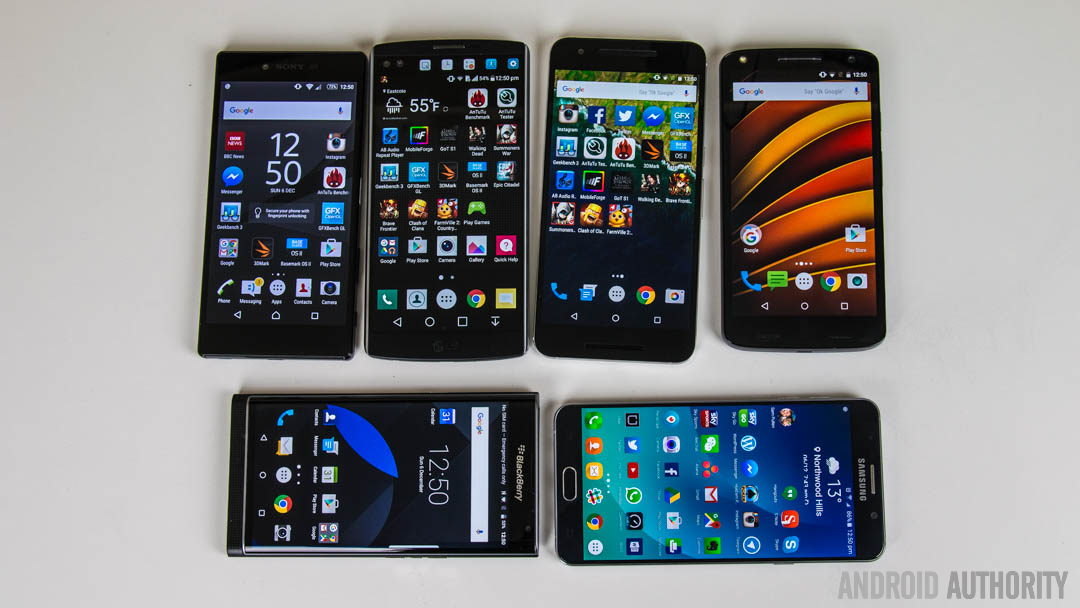
Strategy Analytics has published its latest set of reports into the smartphone industry. The research gives us plenty of information to sift through for global and regional trends, as well as showing which brands are coming out on top and which are struggling to perform in today’s ultra competitive market.
The data is broken down into the following regions: North America, Western Europe, Asia Pacific, Central and Latin America, Central and Eastern Europe, and Africa and the Middle East. It covers the first part of 2016, but the trends it reveals are still relevant and interesting. So let’s dive right on in.
Global Outlook
At the highest level, global smartphone shipments are still strong, but shipments are showing signs of a plateau. This appears to be mostly due to a lack of any further growth in the Asian Pacific markets. Total Q1 2016 smartphone shipments came in at 333 million units, down 3 percent annually compared with Q1 2015’s 345 million shipments. This marks the first even year-on-year decline for the industry.
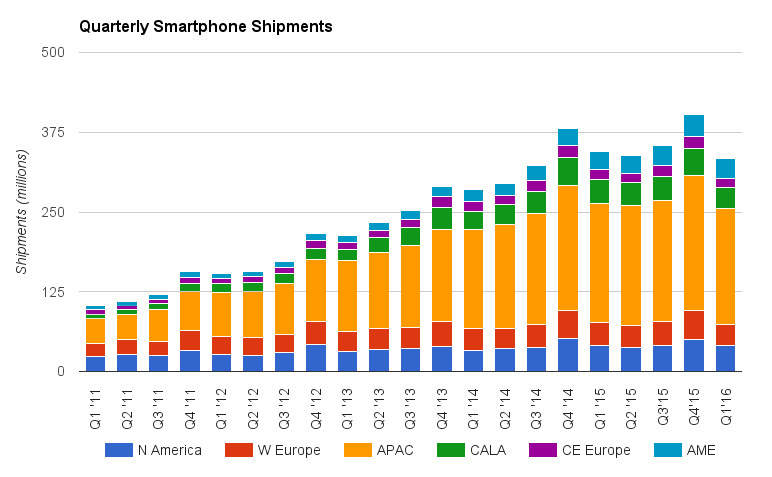
Regionally, it’s now Africa Middle East that is growing the fastest, showing a 10 percent year-on-year boost in sales. The rest of the world is either flat or actually saw small decreases in quarterly shipments. North America sat at 0 percent growth, Asia fell by 2 percent, and Western European shipments fell by a major 10 percent. CE Europe and Central America are the hardest places to do business right now though, with sales down 13 and 15 percent year-on-year for Q1, which is thought to be due to a combination of market maturity and volatile FOREX markets.
Despite a rather drastic change in conditions this year, Samsung remains the dominant smartphone manufacturer, having shipped 79 million smartphones worldwide and grabbing itself a 24 percent market share. Apple continues to play second fiddle with 52.1 million units shipped earlier in the year, a decline of 16 percent YoY. These two brands continue to dominate North America and Western Europe, but are equally dependant on the much more competitive Asian market for sales.
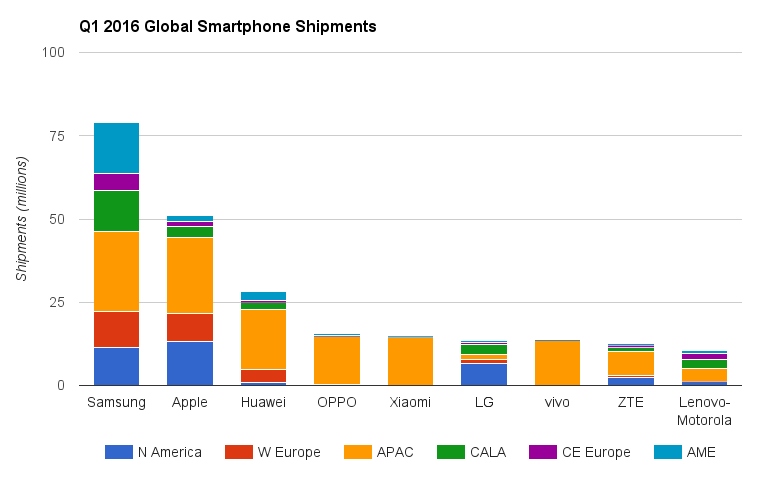
Samsung is by far the most dominant global brand, with significant sales stretching into Africa Middle East, Central America, and Central Europe, as well as its familiar territories. The other major manufacturers in the market now are those who have managed to capitalize on the huge growth in Asian smartphone sales over the past decade.
Low cost, high performance smartphones have been the driving force behind Asia's huge market growth
Five of the top 10 largest smartphone manufacturers now see demand originating mostly from the Asian market, and China in particular. Homegrown Chinese names including OPPO, Xiaomi, and vivo are now much more significant in the global picture than smaller brands that are still familiar to some in the West, including HTC, Sony, and BlackBerry.
Low cost, high performance smartphones have brought millions of more users online, and have been the driving force behind Asia’s huge market growth over the past decade. This change in the make-up of the global smartphone market hasn’t just affected smaller brands, Samsung too has felt the pinch of this additional competition. The smartphone giant’s global market share has gradually declined from highs of 33 percent in Q2 2013 to lows of just 20 percent by Q4 2015. Today it sits at 24 percent and appears to have stabilised.
Samsung’s falling market share is equally a result from a lack of growth in Western markets, with European and North American sales remaining mostly flat, at just 4.3 and -5.5 percent growth retrospectively. Apple, on the other hand, has seen yearly growth rates of 17 and 3.1 percent in the same regions, so there still appears to be consumer appetite for high-end products. Interestingly, Apple still suffers from a highly volatile release cycle, but has not seen the same boom and bust as Samsung over the same period.
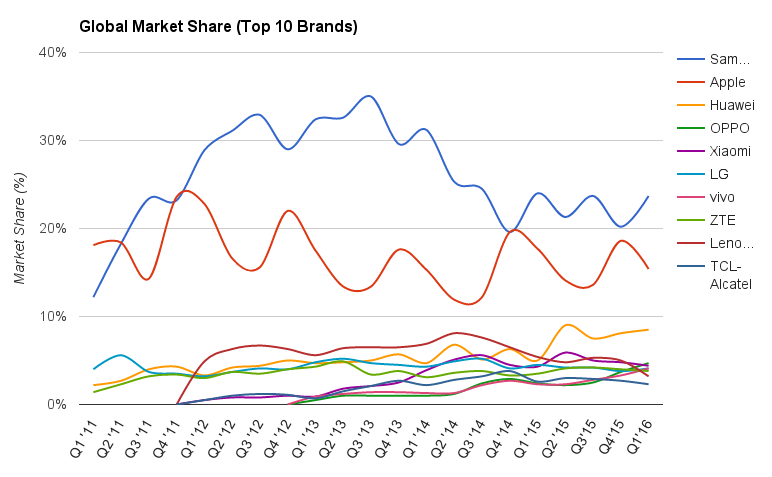
The importance of China
HUAWEI has been the major success story over the past couple of years, having managed to elevate itself out of the rest of the pack and holding a steady and notable third place in the market for the past year. HUAWEI’s market share now sits at a comfortable 9 percent of the global market. Part of this success is down to managing to diversify away from the contested Asian market.
While Asia is HUAWEI’s biggest market, the company also has notable stakes in Western Europe, Central America, and Africa Middle East. Company shipments are up 64 percent year-on-year, with huge Q1 growth in Europe of 344 percent in the West and 100 percent in Central and Eastern territories. The USA is next on the company’s list, as HUAWEI has recently released in HONOR 8 and 5X phones in the country. HUAWEI’s growth in Asia was a smaller, but still very promising 41 percent YoY.
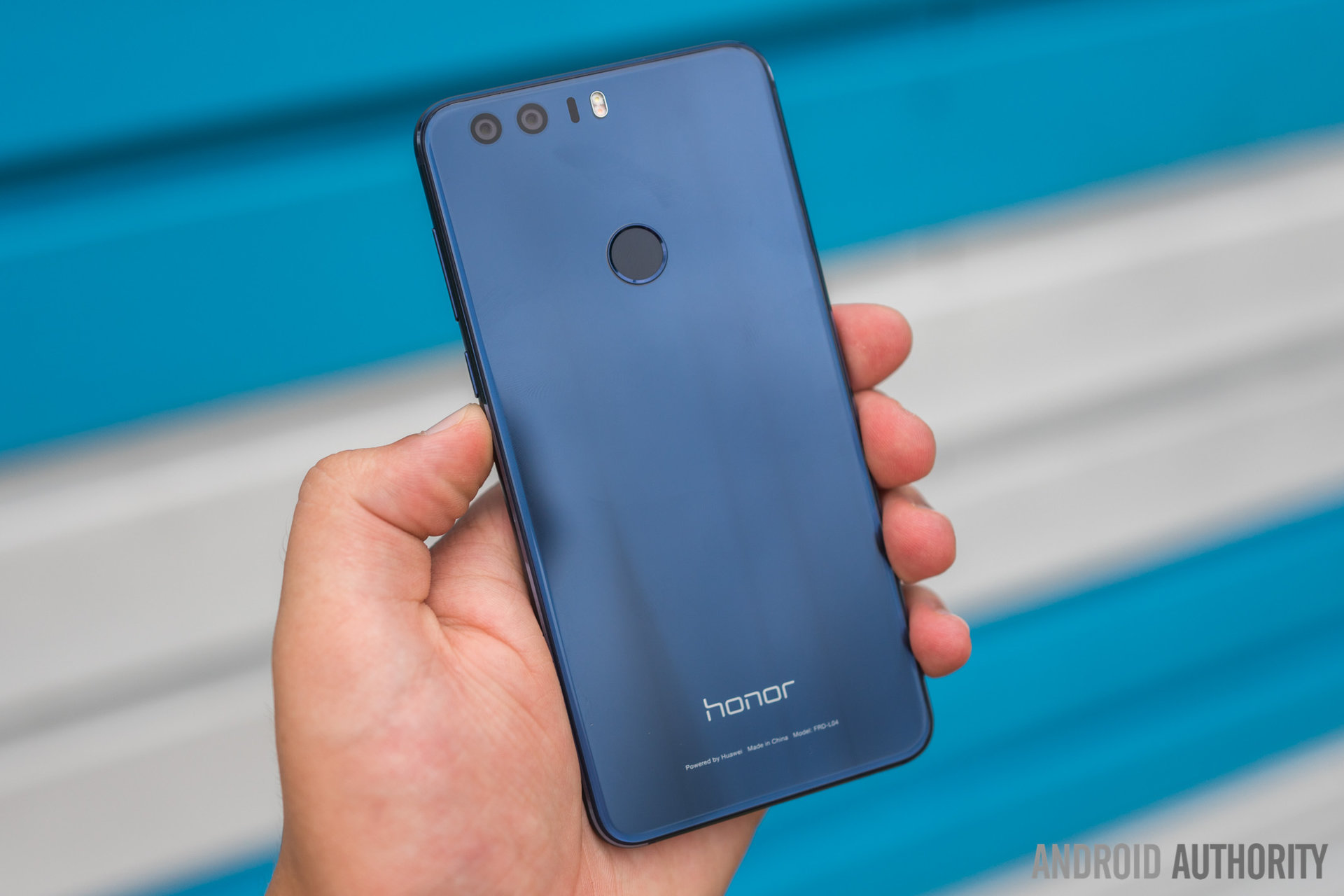
LG, one of the few legacy manufacturers to have held on to an admirable market share, has a similar strategy. LG has a notable presence in North and Central America, and smaller shipment levels in ever other territory. However, unlike HUAWEI, the company hasn’t managed to capture a huge share of the most lucrative Asian markets.
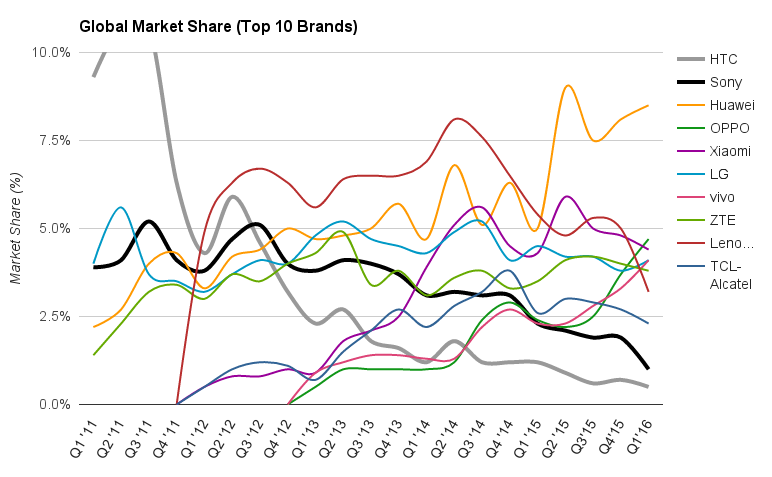
It’s actually rather extraordinary just how many new comers to the mobile market have managed to break into the top 10 in just a few short years. Lenovo, Xiaomi, TCL-Alcatel, vivo, and OPPO are all relative new comers to the market that now make it into the top 10 biggest brands. I have also highlighted data from HTCand Sony on the chart to demonstrate the reverse fortunes of companies who have failed to adapt to new market conditions over the past few years.
By contrast, OPPO has seen its market share shoot into fourth place after an aggressive mid-high end portfolio focusing on localised models for China, along with a push into Africa. Xiaomi also continues to hold on to its share thanks to the size of its Chinese and Indian markets, but the former rising star of the industry hasn’t performed as well as some had expected. The company’s slowed growth only serves to show just how competitive and difficult it has become to operate almost exclusively in the now stagnating Asian market.
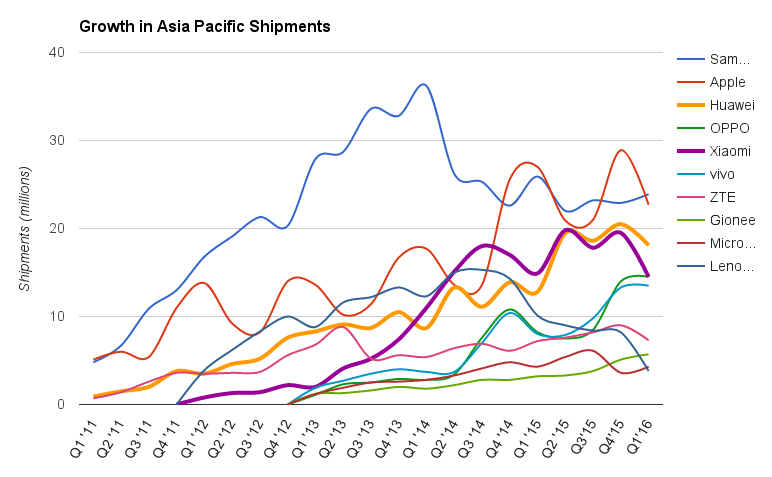
This growth in local brands has come at a notable expense to Samsung’s sales in the region. While Samsung’s S and J series have apparently been selling well in South Korea, the company has failed to cater to the different needs of the the larger Chinese and Indian markets. Consumers are spoilt for choice for lower cost, mid-high tier products. Meanwhile, Apple has strengthened its position in the region by continuing to target the upper-end of the market.
It’s worth noting that success can produce more of the same, while conservative approaches do not appear to be paying off. Forward looking Chinese smartphone brands that are reinvesting in expansions into European and American markets are showing the strongest performances, while those content to sit on a single market are the most vulnerable to losing market share.
Big brands
Clearly, there has been a growing discrepancy between the biggest brands in the West and those in the far East. By charting the Top 5 brands in each region and referencing their sales data for each, we can see just how much more diverse the Asian market currently is than the well established N American and W European regions.
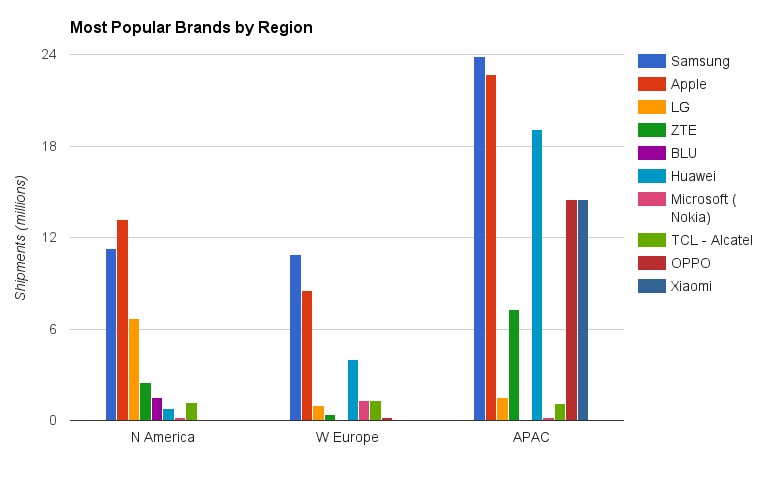
Samsung and Apple are clearly present in all of these markets, but there is very little brand cross-over outside of these two. Even between N America and W Europe we see different brands attempting to fill the gaps left by the big two. In N America, LG still has a notable presence, with BLU and ZTE filling up the other two spaces. Meanwhile in W Europe, HUAWEI takes a strong third places, followed by Microsoft Windows powered phones and then TCL-Alcatel. It’s interesting that both ZTE and HUAWEI also have major market shares in Asia.
In total, there are at least 10 highly noteworthy brands operating in the world’s three biggest smartphone markets. By contrast, we can plot just 6 major brands that make up the vast majority of sales in the other regions of the world.
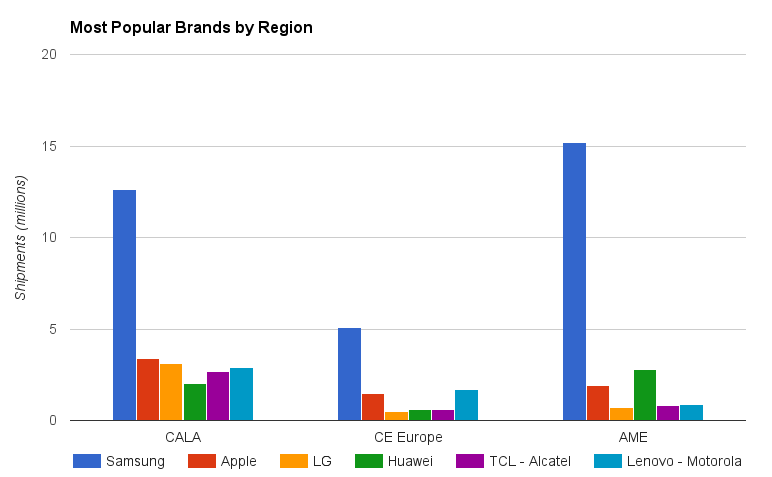
Here we can see that Samsung is by far the most popular brand, with others sharing a mostly equal split of the remaining shipments. As we mentioned before, LG and HUAWEI are performing quite well here. Although it’s Lenovo/Motorola that holds second place in CE Europe, with a 12.2 percent share versus Apple’s 11.7 percent. Apple’s sole focus on premium sales yields no advantage in these countries.
Shifts in the West
With Asia stagnating and markets in Central American and Europe lacking demand to stoke major investments, perhaps there’s an opportunity for brands to look at cracking the dominant positions of Apple and Samsung in the West, or at the very least consolidate the remaining available market share around their brand.
The process has already begun in part, with lower cost manufacturers undercutting the premium price points of the big two and other high-end manufacturers in recent years. In N America, this task has fallen to China’s ZTE and homegrown talent BLU. In W Europe, HUAWEI has been ramping up its attack, and signs are now slowly pointing towards some change.
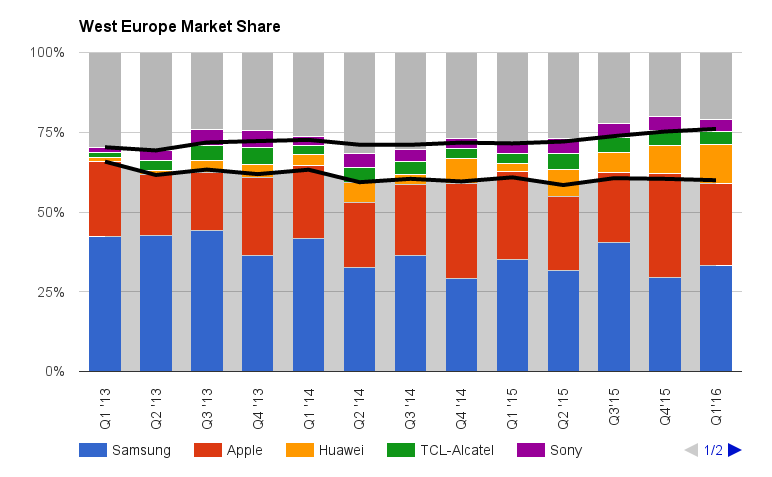
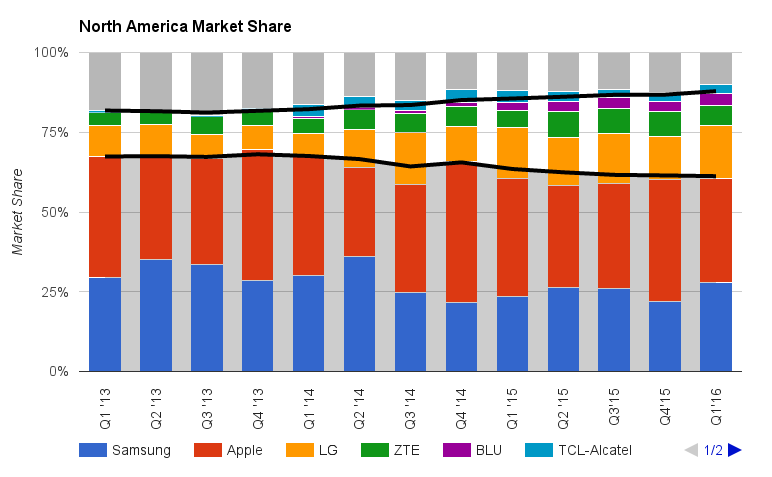
There are at least 10 major brands operating in the world's three biggest markets, but just 6 in the rest of the world.
These changes are most apparent in the US market, where the market is further consolidating behind just a few brands. Even so, newcomer BLU has managed to carve itself out a growing market segment, as have ZTE and LG. Brands that have gradually been pushed out of these Western markets include familiar names such as HTC, BlackBerry, and Lenovo/Motorola in the US.
This is certainly not a fast paced shift that will put any immediate pressure on Samsung and Apple. However, with HUAWEI, and possibly other Chinese brands, looking towards the USA, there’s bound to be increasing pressure on the smallest and biggest brands in the Western market. However, the more these markets consolidate behind a few brands, the harder it will be for newcomers to grab a notable foothold in the market. With these markets stagnant in terms of growth, one company’s loss will be another’s gain.
[related_videos align=”center” type=”custom” videos=”706484,711792,708009,712541″]
Summary
For the first time, the global smartphone market growth came to standstill in early 2016, which is certainly going to change the dynamics in previously fast growing markets such as China and India. As the market consolidates, hungry brands looking for new customers are going to find it tougher to attract brand new customers, and will instead be forced to complete in well established segments. The past few years have already seen the smartphone market heat up considerably, and competition may only grow more fierce as brands collide in search of new customers.
That being said, the development of the Indian, Chinese, and Asian smartphone market isn’t over. There are still new customers to bring online and consumers tastes will development in time as technology becomes more prevalent and affordable. The smaller OEMs that can best adapt to these evolving demands will keep themselves out in front.
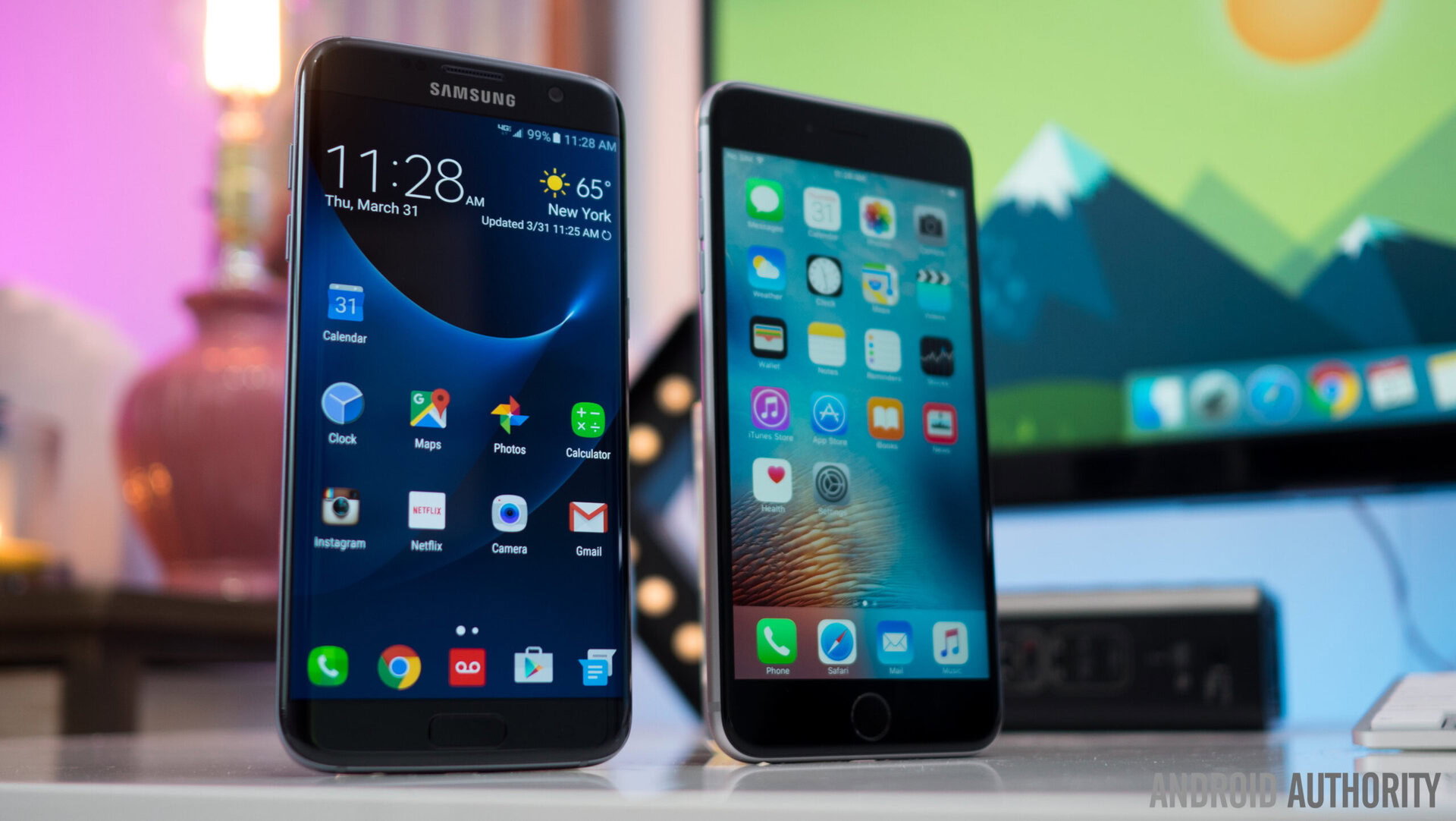
For the big players in the market, there looks to be little respite. Although Samsung’s fall in market share looks to have stabilised, new competition in Western markets and continued price pressure in the East will continue to test Samsung. Likely, the company will continue to depend on its cutting edge technological developments to set itself apart. Apple is in an equally tough spot, having noted a decline in its market share and sales in the past few quarters. For consumers though, the additional choice and competition should set us up for some exciting products over the next couple of years.